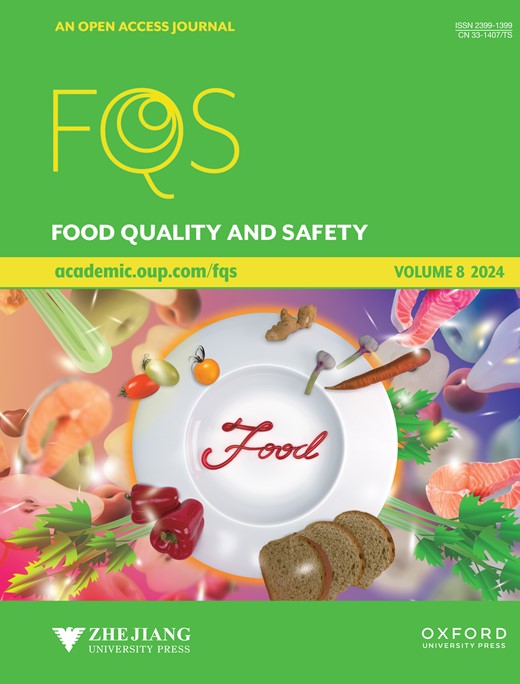Characterization of slightly acidic electrolyzed water on effective disinfection against microbial safety and retention of phenolic compound in SAEW treated fresh romaine lettuce
IF 3
3区 农林科学
Q2 FOOD SCIENCE & TECHNOLOGY
引用次数: 0
Abstract
This study investigated the effects of processing parameters, specifically the low rate and the combination of diluted HCl and salt (NaCl) at different concentrations, on the properties of the slightly acidic electrolyzed water (SAEW) that was produced. The properties of the SAEW that were analyzed included pH, oxidation-reduction potential (ORP), available chlorine concentrations (ACC), and generated hypochlorous acid (HClO) concentration. NaCl alone resulted in the lowest pH (<4) and the highest ORP values (>1000 mV). Increasing HCl concentrations significantly raised pH levels to greater than 5 and lowered ORP values of SAEW, with the highest pH (5.7) observed with 1.5% HCl and 5% NaCl. The highest HClO concentration of 19.65±1.03 mg/L was obtained with 1.5% HCl:5% NaCl. Interestingly, the concentration of NaCl showed no significant effects on the production of HClO. Furthermore, different concentrations of combined NaCl and HCl significantly influenced the inactivation efficiency on total aerobic bacteria count and changes in phenolic compound content. Increasing HCl concentrations from 0.5% to 2.0% led to an increase in the reduction of aerobic bacteria counts from 2.51 to 4.22 log CFU/g with 5% NaCl and from 2.49 to 3.52 log CFU/g with 10% NaCl. Flow rates significantly contributed to the change in HClO formation and altered the properties of the produced SAEW. Results indicated that SAEW treatment significantly reduced total aerobic bacteria counts. The lower flow rates (0.3 L/min) produced the highest log reductions. Additionally, SAEW treatment led to a reduction in phenolic content, even though considerable amount was retained at lower HClO concentrations. These findings offer valuable information on optimizing SAEW treatment protocols for enhancing microbial safety and extending the shelf life of fresh produce, while considering the impact on the content of phenolic compounds.微酸性电解水对 SAEW 处理过的新鲜莴苣中微生物安全和酚类化合物保留的有效消毒特性分析
本研究调查了处理参数(特别是低速率以及不同浓度的稀盐酸和盐(NaCl)的组合)对所产生的微酸性电解水(SAEW)特性的影响。分析的微酸性电解水特性包括 pH 值、氧化还原电位 (ORP)、可用氯浓度 (ACC) 和生成的次氯酸 (HClO) 浓度。单用 NaCl 会导致 pH 值最低(1000 mV)。随着盐酸浓度的增加,SAEW 的 pH 值明显提高到 5 以上,ORP 值降低,1.5% 的盐酸和 5%的 NaCl 产生的 pH 值最高(5.7)。在使用 1.5% HCl:5% NaCl 时,HClO 浓度最高,为 19.65±1.03 mg/L。有趣的是,NaCl 的浓度对 HClO 的产生没有显著影响。此外,不同浓度的 NaCl 和 HCl 对需氧细菌总数的灭活效率和酚类化合物含量的变化有显著影响。将盐酸浓度从 0.5% 提高到 2.0%,可使需氧细菌数量从 2.51 log CFU/g 增加到 4.22 log CFU/g,从 2.49 log CFU/g 增加到 3.52 log CFU/g(盐酸浓度为 5%),从 2.49 log CFU/g 增加到 3.52 log CFU/g(盐酸浓度为 10%)。流速对 HClO 的形成有很大的影响,并改变了所产生的 SAEW 的性质。结果表明,SAEW 处理大大降低了好氧菌总数。较低的流速(0.3 升/分钟)产生的对数减少率最高。此外,SAEW 处理导致酚类物质含量减少,尽管在较低的 HClO 浓度下仍保留了相当数量的酚类物质。这些发现为优化 SAEW 处理方案提供了宝贵的信息,有助于提高微生物安全性和延长新鲜农产品的货架期,同时考虑到对酚类化合物含量的影响。
本文章由计算机程序翻译,如有差异,请以英文原文为准。
求助全文
约1分钟内获得全文
求助全文
来源期刊

Food Quality and Safety
FOOD SCIENCE & TECHNOLOGY-
CiteScore
7.20
自引率
1.80%
发文量
31
审稿时长
5 weeks
期刊介绍:
Food quality and safety are the main targets of investigation in food production. Therefore, reliable paths to detect, identify, quantify, characterize and monitor quality and safety issues occurring in food are of great interest.
Food Quality and Safety is an open access, international, peer-reviewed journal providing a platform to highlight emerging and innovative science and technology in the agro-food field, publishing up-to-date research in the areas of food quality and safety, food nutrition and human health. It promotes food and health equity which will consequently promote public health and combat diseases.
The journal is an effective channel of communication between food scientists, nutritionists, public health professionals, food producers, food marketers, policy makers, governmental and non-governmental agencies, and others concerned with the food safety, nutrition and public health dimensions.
The journal accepts original research articles, review papers, technical reports, case studies, conference reports, and book reviews articles.
 求助内容:
求助内容: 应助结果提醒方式:
应助结果提醒方式:


